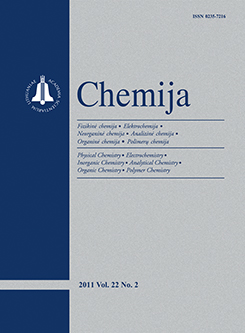Chemija / Chemistry
WHAT?
 ISSN 0235-7216 ISSN 2424-4538 (online) |
2015 m. Nr. 3 Gas chromatographic analysis of polycyclic aromatic hydrocarbons in the disposed creosote treated wooden railway sleepers collected from several storage sites in Lithuania
This paper was presented in the 9th International Conference “The Vital Nature Sign”, held in Kaunas, 14–16 May 2015.
The screening of PAH in used wooden railway sleepers treated with coal tar and creosote for their protection against biodegradation has been made. The analysis was based on cold solvent extraction and Soxhlet extraction of PAH using several organic solvents and analysis by GC-MS/GC-FID. For extraction several organic solvents of different polarity, including aromatic solvents, were tested. The results showed that aromatic solvents are the most efficient solvents for cold solvent extraction with the highest recoveries of PAH from wood matrix. Several PAH were identified. Naphthalene, acenaphthene, fluorene, anthracene, phenanthrene, fluoranthene, pyrene, crysene and benzo[α]anthracene were predominant. Thirty samples from Central Lithuania and twenty from the results of chemical analysis the samples were classified using the cluster analysis according to several parameters including age, decay status and chemical composition of the extract of the sleeper. The composition of PAH varies between intact and rotten sleepers. Few sleeper samples differ from others with a strong coal tar odor and a dark color and very high quantities of PAH. Keywords: wooden railway sleepers, coal tar, creosote, polycyclic aromatic hydrocarbons, gas chromatography–mass spectrometry, cold solvent extraction |
Issues:
2017 - Vol.28 No. 1, No. 2, No. 3, No. 4 2016 - Vol.27 No. 1, No. 2, No. 3, No. 4 2015 - Vol.26 No. 1, No. 2, No. 3, No. 4 2014 - Vol.25 No. 1, No. 2, No. 3, No. 4 2013 - Vol.24 No. 1, No. 2, No. 3, No. 4 2012 - Vol.23 No. 1, No. 2, No. 3, No. 4 2011 - Vol.22 No. 1, No. 2, No. 3, No. 4 2010 - Vol.21 No. 1, No. 2-4 2009 - Vol.20 No. 1, No. 2, No. 3, No. 4 2008 - Vol.19 No. 1, No. 2, No. 3-4 2007 - Vol.18 No. 1, No. 2, No. 3, No. 4 2006 - Vol.17 No. 1, No. 2-3, No. 4 2005 - Vol.16 No. 1, No. 2, No. 3-4 2004 - Vol.15 No. 1, No. 2, No. 3, No. 4 2003 - Vol.14 No. 1, No. 2, No. 3, No. 4 2002 - Vol.13 No. 1, No. 2, No. 3, No. 4 2001 - Vol.12 No. 1, No. 2, No. 3, No. 4 |